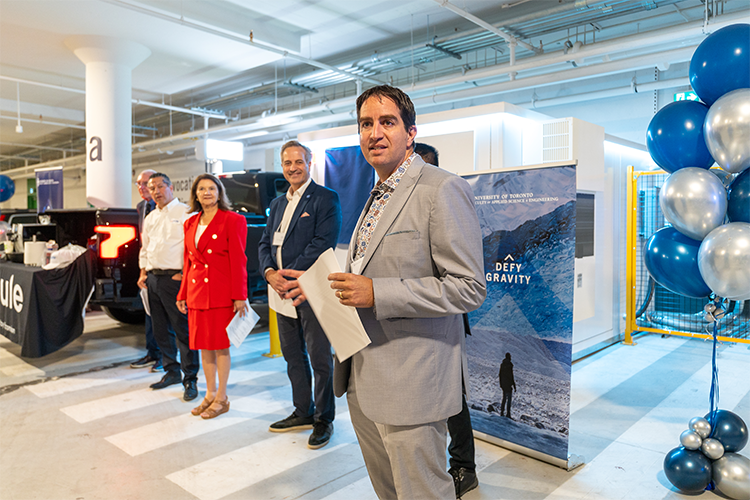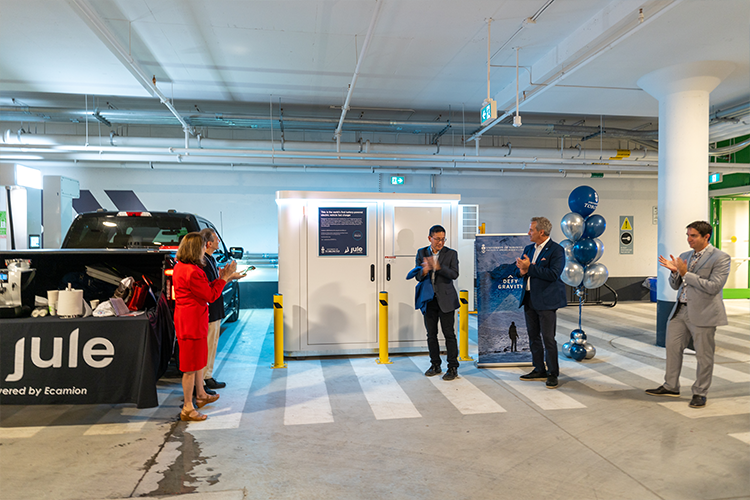Super facts about superchargers on campus
The first-ever level 3 electric vehicle (EV) chargers on campus impress with their speed and cutting-edge technology.
At the University of Toronto’s new Landmark Garage, located underneath King’s College Circle, two new fast chargers have been installed to support electric vehicle (EV) use on campus.
On Thursday September 19, a ribbon-cutting ceremony was held to mark the official opening of the charging stations. In attendance were U of T President Meric Gertler, Dean of Engineering Christopher Yip, Toronto City Councillor Dianne Saxe, representatives from Jule Energy, and journalists, including the team from CityTV: Breakfast Television. You can learn more about the development of these superchargers from the Department of Engineering here.

Here are a few things you might not know about the level 3 chargers:
1. They can charge a typical EV in under 30 minutes
When it comes to EV charging, the higher the level, the faster the charge—with level 3 being the top tier. While level 1 chargers take over 20 hours to fully prime an EV, the level 3 models can fully prime a battery in just half an hour.
2. They use batteries to charge your car
Rather than directly connecting a car to the power grid, level 3 chargers use power stored in their own battery packs, a novel approach that significantly reduces electrical infrastructure upgrades—and therefore, cost—required for installation. As a result, these chargers deliver a fast charge of up to 200 kW, yet only need 45 kW of input power!
Looking ahead, the level 3 chargers have the capability to return energy back into the Ontario grid through a process called bidirectional charging. With the flick of a switch, the energy stored in the charger’s battery pack—and even the connected vehicles themselves—could provide excess energy back to the grid, helping the province manage peak electricity demand.
“This is one step in our journey towards not only sustainability, but ultimately regenerative sustainability,” says Scott Hendershot, senior manager, Sustainability Office. “We’re not just looking for ways to reduce our impact—we’re actually working to improve our environment.”

3. There are now 50 EV chargers available directly below front campus
Conveniently located in the southwest corner of the garage, the new level 3 chargers join the 48 level 2 chargers available for public use—increasing the campus’s charging capacity to over 25,000 per year. This works out to a GHG emissions reduction of over 700 tonnes!
Cars are allowed to park in the fast charger spots for as long as they need to charge, after which point they must vacate the space. The process is much the same as that of a gas station: drivers fill up their cars, pay, and depart.
Given that there are only a dozen or so fast chargers in downtown Toronto, Hendershot hopes the new campus infrastructure will further encourage EV usage and reduce emissions. “We want U of T to help drive the transition away from fossil-fueled transportation—and empower others to do the same,” he says.
Meanwhile, F&S continues to move forward with installation of more level 2 chargers to support its expanding fleet of EVs.
By increasing access to fast chargers, U of T continues to trailblaze sustainability efforts on a local and global scale, carrying on the efforts that led to it being named the most sustainable university in the world last year.
